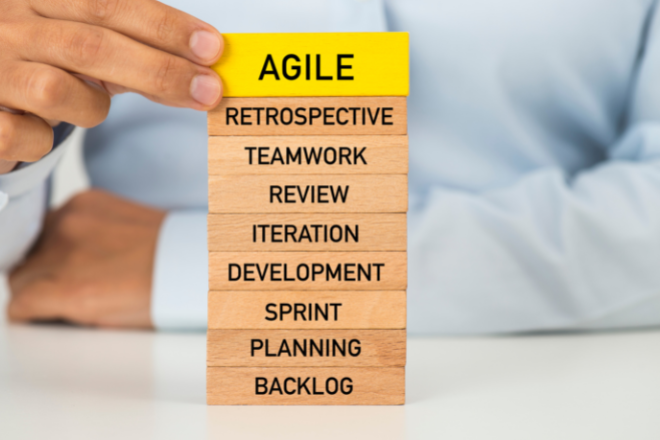Agile ways of working for more effective teamwork

If you’re a professional that’s looking to improve your team/business’ ability to collaborate, then the Scrum framework may prove to be useful. Scrum is an Agile project management system that involves constant and incremental improvement, allowing your team to adjust their operations instantaneously, rather than having to move at a slow, lethargic pace. Whether you’re a Scrum Master/looking to become one, or just want to improve your project management methods, read on to learn more!
What is the Scrum framework?
The Scrum framework is designed to help production teams take an idea and turn it into a functional product/solution/update. It stems from the Agile mindset, which revolves around collaboration and flexibility. Teams that think with an Agile mindset are open to change rather than resisting it, and they understand that change is conducive to success, rather than a hindrance.
The Scrum framework revolves around two-to-four-week sprints, each of which are self-contained (you can read more about the distinct phases of a sprint later). The framework is flexible and is designed to help both team leaders and team members to work at maximum effectiveness. The Scrum framework means that businesses can implement a project management system that can scale based on their needs. Whether your team is small or large, the principles of the Scrum framework remain the same – and new team members can learn from those well-versed in Agile practices to get up to speed more quickly.
The Scrum Master/s are the ones who take charge of the implementation and running of the Scrum framework. They will ensure that the framework is working for all team members and that everyone is committed to working with an Agile mindset. While they will adhere to Scrum’s processes, they will also be flexible and open to productive change. More than anything else, they should be willing to collaborate with everyone to ensure that the results of each sprint are meeting (and exceeding) expectations.
What are the benefits of the Scrum framework?
A collaborative workplace is a happy and productive workplace, and the Scrum framework encourages people to work together. However, there are other benefits to the Scrum framework, such as:
- It promotes defined goals – each sprint is a chance to create something tangible
- Continuous improvement – each sprint retrospective is a chance to reflect and adapt before heading into the next sprint
- Flexibility – constant feedback means that teams aren’t waiting for long periods of time to understand how their achievements are being received by other teams
The Scrum framework may not work for every business, but when implemented correctly, it can help businesses achieve results that might not be possible if they stick with their current processes. PwC reported in 2017 that Agile projects are 28% more successful than their traditional counterparts when reporting on businesses that were switching to Agile Product Delivery methods, which can be considered similar to the Scrum framework. Moving with speed and precision is key to the success of any business, and by implementing the Scrum framework, you’re more likely to produce work that will help your customers solve their most stubborn problems.
What are the different phases in the Scrum Framework?

There are typically four Scrum phases within each sprint, and each phase is designed to help teams thrive. These include:
1. Sprint planning
During sprint planning, everyone agrees on the expected outcomes for the sprint and works out how those outcomes will come to fruition. Everyone participates in sprint planning, and it’s a chance for people to align their expectations.
2. Daily stand-up
Stand-up meetings involve the core Scrum team and are chances for those involved to ensure things are running smoothly. During this time, everyone has a chance to discuss the events of the next 24 hours so people can report on what they have achieved and what they are set to achieve, as well as solve any problems that might be hindering progress.
3. Sprint review
The sprint review is a chance for the team to assess what work’s been completed to date, and whether any chances are made. It’s a key part of the Scrum framework, and it often involves the development team showing relevant stakeholders a demo of the new product/features/solution that has been created. It’s a chance for feedback to be shared between team members so people continue to work in harmony.
4. Sprint retrospective
The end of a sprint involves a sprint retrospective, which is a time to reflect on the previous sprint and plan for the next sprint. Whether things were smooth or choppy, sprint retrospectives are part of the Scrum framework’s ability to facilitate continuous improvement. Each sprint should be more productive and rewarding than the last, and a productive sprint retrospective primes the team for increased success going forward.
It’s worth noting that while the Scrum framework is defined, it is also able to be adapted depending on your team’s needs. No two implementations of the Scrum framework are exactly the same, and your team may very well find that aspects of the framework benefit the team, while others hold them back. It’s up to your Scrum Master/s to optimise and adapt your processes following each completed sprint – which is one of the many benefits of the Scrum framework
Interested in learning more about the Scrum framework, or just looking to improve your professional skillset? Upskilled provides a range of nationally recognised qualifications in a vast range of sectors to help you work towards your next career move. You can learn more about Upskilled’s range of courses here, or reach out to get in touch with Upskilled’s education consultants!


)
)

